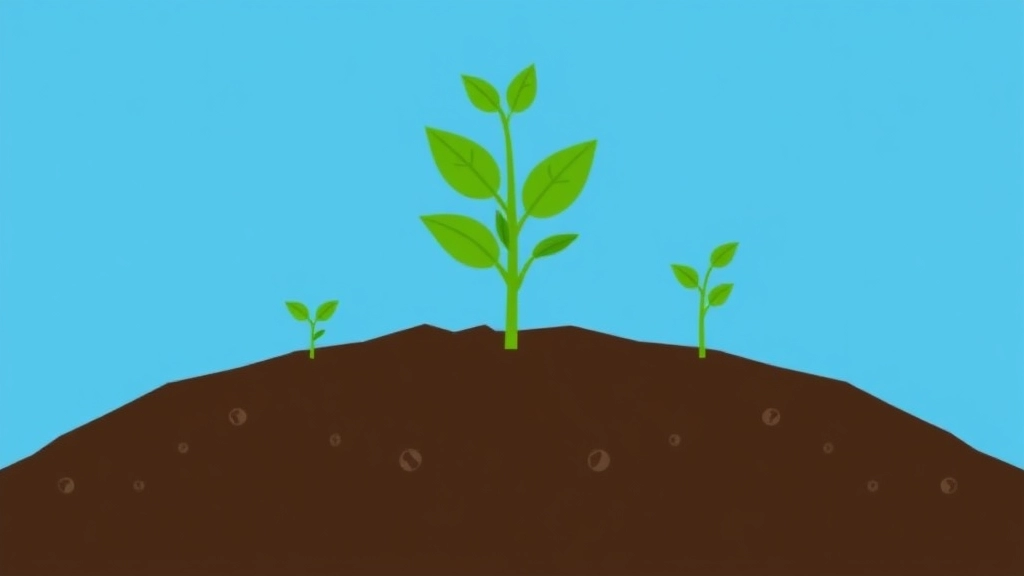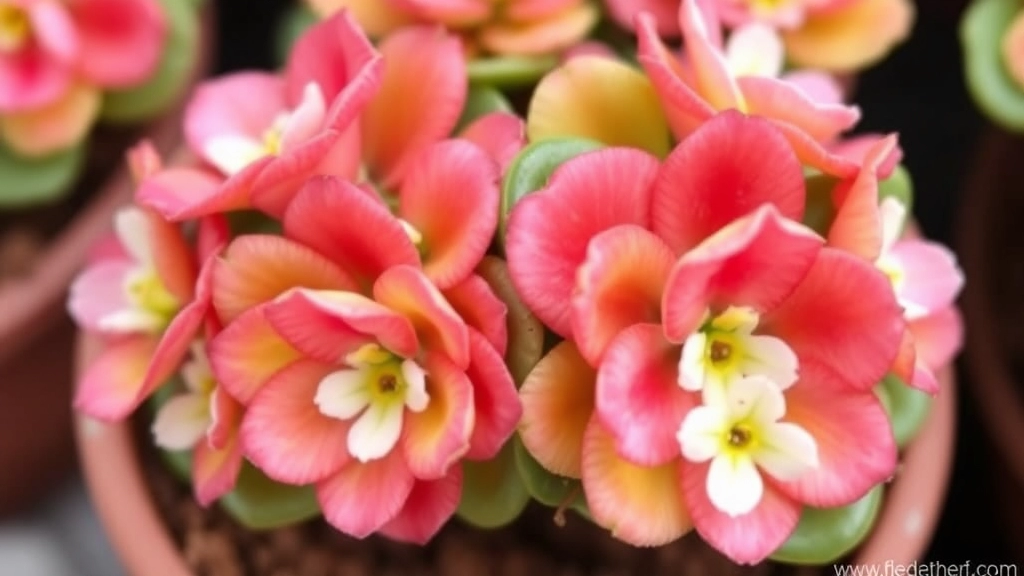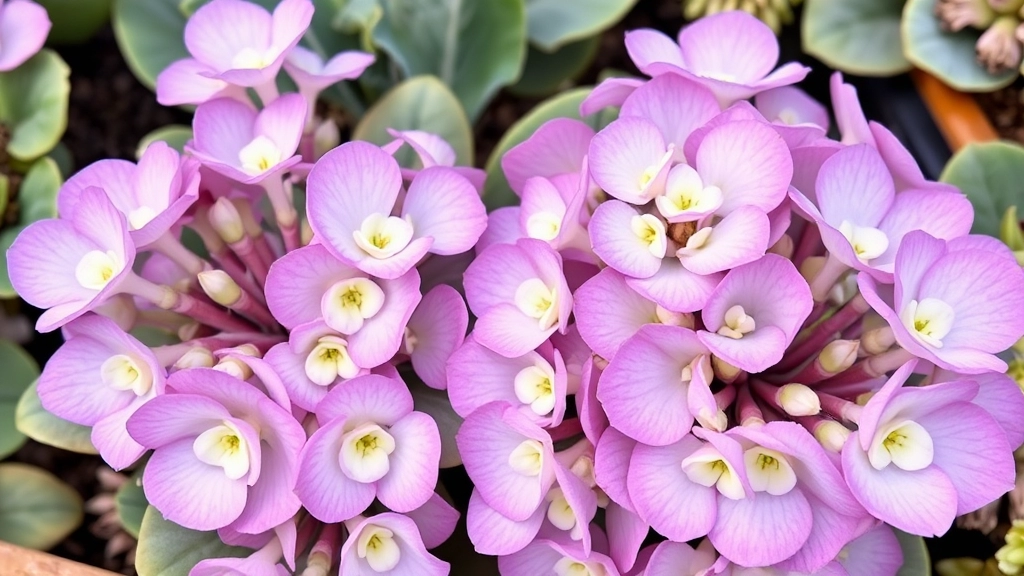Kalanchoe Fedtschenkoi Care Guide
If you’re looking to keep your Kalanchoe Fedtschenkoi, also known as Lavender Scallops, thriving, you’re in the right place. This succulent is not only eye-catching but also relatively easy to care for with the right tips. Let’s dive into the essential care requirements, from optimal light conditions to watering and soil guidelines, ensuring your Lavender Scallops flourish.
Light and Temperature Needs
Understanding the light and temperature needs of Kalanchoe Fedtschenkoi is crucial. This succulent prefers partial sun or bright indirect light and thrives in temperatures that don’t dip below freezing. Proper watering and well-draining soil are also key to preventing root rot and promoting healthy growth. Stick around to learn more about fertilizing, propagation methods, and keeping pests at bay, ensuring your Lavender Scallops stay vibrant and healthy.
Light and Temperature Requirements for Lavender Scallops
When cultivating Lavender Scallops, understanding their light and temperature needs is crucial for their thriving growth. Many plant enthusiasts often wonder: How much light do these unique plants require? What temperature range is ideal for their development?
Light Requirements
Lavender Scallops thrive best in bright, indirect sunlight.
- Optimal Light Exposure: Aim for around 6 hours of indirect sunlight daily.
- Avoid Direct Sunlight: Too much direct sun can scorch the leaves, causing unsightly brown spots.
- Indoor Placement: If grown indoors, placing them near a south-facing window is ideal.
Temperature Preferences
Temperature plays a significant role in the health of Lavender Scallops.
Watering and Soil Guidelines for Healthy Growth

So, you’ve got your Lavender Scallops, and you’re probably wondering how to keep them thriving, right?
One of the biggest concerns is getting the watering and soil just right.
Watering Tips
Lavender Scallops love a good drink, but too much can drown them. Here’s how to strike that perfect balance:
- Watering Frequency: Aim to water every 1-2 weeks.
- Soil Drying: Always check if the top inch of soil is dry before watering again.
- Drainage: Ensure your pots have drainage holes. Standing water is a no-go!
Soil Guidelines
Now, let’s chat about soil. The right mix is key to happy plants:
- Well-Draining Mix: Use a gritty mix or cactus soil. This keeps the roots from sitting in water.
- pH Level: Lavender Scallops thrive in slightly acidic to neutral soil (around pH 6 to 7).
- Additives: Consider adding perlite or sand for extra drainage.
When it comes to nurturing your Lavender Scallops, fertilization plays a pivotal role in ensuring their vibrant growth and health. You might be wondering: how do I keep my plants thriving without overwhelming them with nutrients?
Lavender Scallops are relatively low-maintenance when it comes to fertilization. However, providing the right nutrients can significantly enhance their appearance and resilience.
– **Type of Fertilizer**: Opt for a balanced, water-soluble fertilizer. A ratio of 10-10-10 or 20-20-20 is ideal.
– **Frequency**: During the growing season (spring and summer), fertilize every 4-6 weeks. In the dormant months (autumn and winter), reduce or even halt fertilization.
– **Dilution**: Always dilute the fertilizer to half the recommended strength to avoid burning the roots.
Keep an eye out for signs that your Lavender Scallops might need a nutrient boost:
– **Pale Leaves**: This can indicate a nitrogen deficiency.
– **Stunted Growth**: If your plants aren’t growing as expected, they may require more nutrients.
If you prefer a more natural approach, consider using:
– **Compost**: Rich in nutrients, it can be mixed into the soil.
– **Fish Emulsion**: A great organic fertilizer that provides essential nutrients.
By understanding the fertilization needs of your Lavender Scallops, you can help them flourish beautifully. For more detailed care instructions, you might find our [complete guide to growing Kalanchoe Mother of Thousands](https://planthq.org/complete-guide-to-growing-kalanchoe-mother-of-thousands/) helpful. Additionally, if you’re experiencing issues with leaf health, our article on [causes and solutions for brown spots on Kalanchoe leaves](https://planthq.org/causes-and-solutions-for-brown-spots-on-kalanchoe-leaves/) can provide valuable insights.
Propagation Methods for Kalanchoe Fedtschenkoi

When it comes to propagating Kalanchoe Fedtschenkoi, many plant enthusiasts often wonder about the most effective methods. This succulent, known for its captivating foliage and resilience, offers several straightforward propagation techniques.
1. Leaf Cuttings
One of the simplest ways to propagate Kalanchoe Fedtschenkoi is through leaf cuttings. Here’s how you can do it:
- Select a Healthy Leaf: Choose a mature, healthy leaf from the parent plant.
- Cut the Leaf: Use a clean, sharp knife or scissors to cut the leaf at the base.
- Allow to Callous: Place the leaf on a dry surface for 2-3 days to allow the cut edge to callous over.
- Planting: Once calloused, place the leaf in well-draining soil, ensuring the cut edge is in contact with the soil.
- Water Sparingly: Mist the soil lightly and place the pot in a warm, bright location.
2. Offsets
Kalanchoe Fedtschenkoi naturally produces offsets, or “pups,” that can be easily separated and replanted.
- Identify Offsets: Look for small plants emerging from the base of the parent.
- Remove Offsets: Gently twist or cut the offset away from the parent plant, ensuring some roots are attached.
- Replant: Place the offset in a new pot with well-draining soil.
- Care for New Plants: Water lightly and provide bright, indirect light.
3. Stem Cuttings
Another effective method is using stem cuttings, which can yield quick results.
- Select a Stem: Choose a healthy stem that is at least a few inches long.
- Cut the Stem: Use clean tools to cut the stem just below a leaf node.
- Callous the Cutting: Allow the cutting to dry and callous for a couple of days.
- Plant in Soil: Insert the cutting into well-draining soil and water lightly.
- Provide Proper Light: Place it in a bright area, avoiding direct sunlight until roots develop.
By utilising these propagation methods, you can expand your collection of Kalanchoe Fedtschenkoi with ease.
Pests and Diseases: Prevention and Solutions
When nurturing lavender scallops, the threat of pests and diseases can loom large.
What if your plant starts wilting unexpectedly?
Or you notice tiny bugs crawling around?
These concerns can be daunting, but with the right strategies, you can keep your plants healthy and thriving.
Toxicity and Safety Precautions for Pets
So, you’ve got a lovely Kalanchoe Fedtschenkoi, also known as Lavender Scallops, sitting pretty in your home. But waitâare they safe for your furry friends? It’s a valid concern, especially if you have curious pets that love to investigate every nook and cranny.
Are Lavender Scallops Toxic?
Yes, Kalanchoe plants can be toxic to pets, particularly cats and dogs. The leaves contain compounds that can lead to symptoms like:
- Vomiting
- Diarrhoea
- Lethargy
- Drooling
If your pet nibbles on a leaf, don’t panic just yet! Most cases are mild, but it’s always better to be safe than sorry.
What Can You Do?
Here are some simple safety precautions to keep your pets safe while you enjoy your beautiful plant:
- Placement: Keep your Lavender Scallops out of reach. High shelves or hanging planters are great options.
- Distraction: Provide your pets with safe chew toys or plants, like cat grass, to keep them occupied and away from your Kalanchoe.
- Education: If you have visitors with pets, inform them about the plant’s toxicity to prevent any accidents.
- Monitoring: Keep an eye on your pets. If they show any unusual behaviour after being around the plant, consult your vet.
What If Your Pet Eats Some?
If you suspect your pet has ingested part of the plant, it’s crucial to act quickly:
- Don’t Panic: Most cases are not life-threatening.
- Contact Your Vet: Describe what happened and follow their advice.
- Observe Symptoms: Keep an eye on your pet for any changes in behaviour.
By taking these precautions, you can enjoy your Lavender Scallops without worrying about your pets. For more detailed information, you can read about Kalanchoe plant toxicity and explore common leaf problems to ensure your plant stays healthy.
FAQs on Kalanchoe Fedtschenkoi and Lavender Scallops
How often should I water my Lavender Scallops?
Lavender Scallops should be watered every 1-2 weeks. Always check if the top inch of soil is dry before watering again to avoid overwatering.
What type of soil is best for Lavender Scallops?
They thrive in a well-draining mix, such as gritty or cactus soil. It’s also beneficial to add perlite or sand to improve drainage.
What is the ideal pH level for the soil of Lavender Scallops?
Lavender Scallops prefer slightly acidic to neutral soil, with a pH level around 6 to 7.
How can I propagate Kalanchoe Fedtschenkoi?
Kalanchoe Fedtschenkoi can be propagated through leaf cuttings, offsets, or stem cuttings. Each method involves specific steps to ensure successful propagation.
What are the steps for propagating Kalanchoe Fedtschenkoi using leaf cuttings?
To propagate using leaf cuttings:
- Select a healthy leaf from the parent plant.
- Cut the leaf at the base using a clean, sharp knife or scissors.
- Allow the cut edge to callous for 2-3 days.
- Place the leaf in well-draining soil with the cut edge in contact with the soil.
- Mist the soil lightly and place the pot in a warm, bright location.
What are offsets in Kalanchoe Fedtschenkoi and how do I use them for propagation?
Offsets, or “pups,” are small plants that emerge from the base of the parent plant. To propagate using offsets:
- Identify the offsets at the base of the parent plant.
- Gently twist or cut the offsets away, ensuring some roots are attached.
- Replant the offsets in new pots with well-draining soil.
- Water lightly and provide bright, indirect light.
How do I propagate Kalanchoe Fedtschenkoi using stem cuttings?
To propagate using stem cuttings:
- Select a healthy stem that is at least a few inches long.
- Cut the stem just below a leaf node using clean tools.
- Allow the cutting to dry and callous for a couple of days.
- Insert the cutting into well-draining soil and water lightly.
- Place it in a bright area, avoiding direct sunlight until roots develop.
Why is drainage important for Lavender Scallops?
Proper drainage is crucial to prevent the roots from sitting in water, which can lead to root rot. Ensure your pots have drainage holes to allow excess water to escape.
References
-
Growing Lavender Scallops
-
Kalanchoe Propagation Methods
-
Types of Succulents: Kalanchoe Fedtschenkoi
